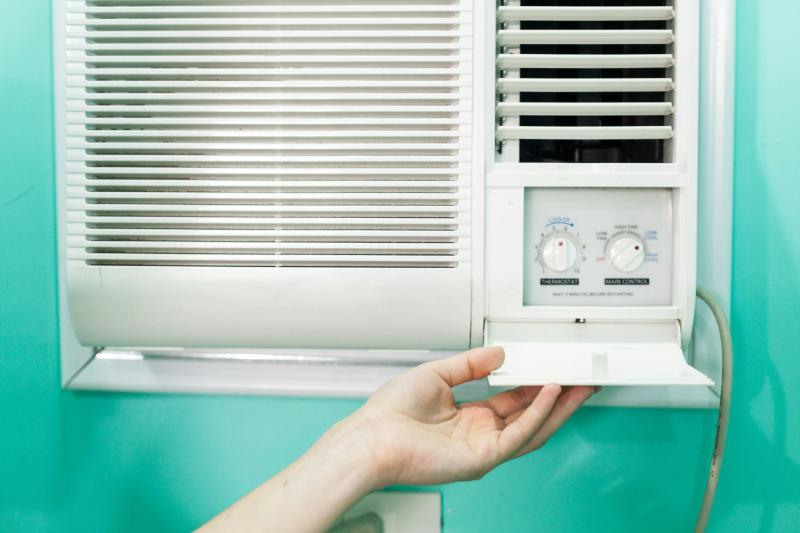Are you trying to beat the heat and looking for ways to stay cool indoors? In hot and humid climate, such as Florida or the Philippines, a window air conditioner is one solution. This compact, convenient cooling unit offers a respite from the relentless warmth, transforming homes into cool havens.

Indeed, as temperatures soar, so does the demand for window type aircon units. But are they operating at their utmost potential? If you’re keen to discover how to maximize the cooling power of your window aircon, here are some tips that can help:
Select the Right Size and Energy Efficiency
The key to maximizing the performance of your window air conditioner is to choose the appropriate size based on the floor area of the room where you plan to install it. Simply put, the size of the aircon should match the cooling area of the space, as measured in British thermal units (BTU) per hour or kilojoules (kJ) per hour. For a 15 to 19 square meter room, you’re going to want a window-type aircon with a 9,000 to 9,500 BTU or kJ per hour capacity. An undersized unit will struggle to cool a room, whereas an oversized one may result in inefficient cycling and excess humidity. Both under- and oversized aircons will also consume more energy than needed.
Speaking of energy consumption, it’s best to choose an aircon with an Energy Star rating. These units use less energy and provide efficient cooling, which can help you save money and contribute to environmental protection.
Install and Position the Unit Properly
Where and how your air conditioner is installed can significantly affect its efficiency. A unit positioned in a window that receives direct sunlight will have increased operational demand, because the additional heat from the sun also increases the room’s temperature. As a result, the air conditioner uses more energy to achieve and maintain the desired coolness.
Therefore, it’s best to place your window aircon unit in a shaded window or area that doesn’t get a lot of sun exposure. If needed, add a small roof or awning to shield the aircon from sunlight. The installation height also matters. For optimal air circulation, install the air conditioner about 3 to 4 feet above floor level. Finally, ensuring that the unit is well supported and adequately sealed is crucial to prevent cool air from leaking out and warm air from seeping in.
Schedule Regular Maintenance
Like any appliance, window air conditioners require regular maintenance to operate at their best. This includes routine tasks such as cleaning or replacing the air filter every month, which improves air quality and enhances efficiency. Have your unit inspected for debris and you may be surprised by what and how much can get caught in the filter—like insect nests! These and other bits of dirt, pollen, and other contaminants can hinder its performance.
The condenser coils should also be cleaned by a professional at least once a year to maintain effective heat transfer, although the frequency may vary depending on usage. If you notice a decline in your aircon’s performance, see if it needs cleaning.
Optimize Your Home Environment for Better Cooling
What most people don’t know is that the efficiency of an air conditioner—whether it’s a window-type or split-type unit—depends not only on the aircon itself but also on how you manage your home environment. For example, studies have reported that proper window coverings can reduce heat gain in a room by up to 77%, thus improving an aircon’s cooling efficiency.
Consider the use of insulated cellular shades or other energy-efficient window treatments to provide shade and insulation, and thus aid in temperature control. Even traditional curtains or window blinds will help minimize heat. It is equally important to keep doors and windows closed to prevent cool air from escaping. This practice prevents your air conditioner from working excessively to cool areas beyond its intended range.
Finally, when choosing a place to install the aircon, it’s best to pick a spot that doesn’t receive a lot of direct sunlight. This will further reduce the cooling load of the unit.
Limit the Use of Heat-Producing Appliances and Electronics
If you want to relax in a cool room and “assist” your air conditioner to keep or amplify the coolness level, try turning off or limiting the use of other appliances and electronics. The heat generated by some of your appliances and gadgets can counteract the cooling effect of your air conditioner. This is especially true for kitchen appliances and high-energy electronics that emit a considerable amount of heat. Limiting your usage of these items, particularly during the hottest parts of the day, can reduce the thermal load on your air conditioner, increase cooling efficiency, and reduce energy consumption. Simple changes like avoiding using the oven during noon and opting for cooler cooking methods can make a noticeable difference in room temperature.
Boost the Cooling Capacity of Your Window Aircon
The tips outlined in this article highlight how being strategic in using and maintaining your window-type aircon can lead to a better and more efficient performance. Adopting these practices results in improved comfort and reduced energy consumption, so that you can beat the heat with a more efficient, effective, and eco-friendly cooling approach.
